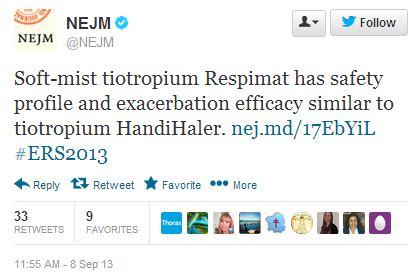In an article on engagementstrategy.com, Paul Grant outlined his model of the drivers for engagement in social media. Since the article was published, Creation Pinpoint studies have highlighted a range of Healthcare Professional (HCP) behaviours on public social media. In this post, using the topic of chronic obstructive pulmonary disease (COPD) as an example, I will outline some of the most commonly-seen behaviours, giving an insight into what may be important for HCPs online.
Chronic Obstructive Pulmonary Disease (COPD) is a term used to describe chronic lung conditions including emphysema and chronic bronchitis. According to the the European Respiratory Society, along with lung cancer, these diseases represent a leading cause of mortality in Europe, and incidence is predicted to rise. Respiratory health is therefore an important area of research and development for many pharmaceutical companies. Using Creation Pinpoint, we looked at the topics of discussion among HCPs around COPD and its treatments since 1 September this year.
Four drivers for HCP engagement on public social media
Four overlapping drivers for HCP engagement on public social media are proposed here:
- Creating news – activities such as broadcasting information that may be of interest to others
- Consuming news – staying in touch with new developments in the field
- Caring for patients – learning new ways to help patients, beyond the latest drugs
- Collaborating, building networks – being involved in an community free of boundaries
The following word cloud demonstrates the most mentioned topics during the study period. ERS2013, the annual congress of the European Respiratory Society, is prominent, as the hashtag ERS2013 was tweeted and re-tweeted multiple times.
That conference hashtags exist, and that they are used shows that these offline events have an important mirror image in the online world. The most common behaviour seen at conferences is the tweeting of nuggets of information, which is essentially the “creation” of content that is predicted to be of interest to others. Doctors may also use conferences to add the “in real life” dimension to networks they have created with colleagues online.
Caring for patients
The following tweet, from the Twitter account of the PROactiveCOPD project (which is looking at developing a patient-reported outcome for physical activity in COPD) was re-tweeted by 3 HCPs. PROactiveCOPD also appears in the topic cloud above, suggesting further discussion around the topic of physical activity in COPD.
Resources and tips that could help the patients a HCP cares for, as well as advice from colleagues, can be important online assets for HCPs. These resources and tips may go beyond the latest drug therapies.
Another aspect of caring for patients that was not seen in this study, but that has been observed in small measures elsewhere, is direct HCP-patient interaction online. This does not generally reach large volumes, since it can be a complex area for HCPs to navigate – a doctor needs to be clear about a patient’s medical history and the details of their complaint before suggesting a course of action, and examinations and tests may also be required. There is also scope for a patient to misinterpret information given online. Some HCPs state clearly on their social media profiles that they do not provide medical advice online.
Consuming news and staying ahead
HCPs make use of the instant nature of media such as Twitter to keep informed of the latest news and study results before it reaches journals and other professional publications. Below is an example of a link to a study that was re-tweeted 33 times, and ‘favourited’ 9 times, showing how important new clinical information is to HCPs online.
Collaborating and sharing
The online space is unique as it removes hierarchical and geographical boundaries. The Free Open Access Medical Education (FOAMMed) movement capitalises on this. As described on the FOAM web page,
“FOAM is the movement that has spontaneously emerged from the exploding collection of constantly evolving, collaborative and interactive open access medical education resources being distributed on the web with one objective — to make the world a better place. FOAM is independent of platform or media — it includes blogs, podcasts, tweets, Google hangouts, online videos, text documents, photographs, facebook groups, and a whole lot more.”
FOAM appears in the topic cloud above, as the hashtag was used to “label” tweets that were considered to be related to FOAM.
This behaviour shows that HCPs are interested in collaborating and sharing online – as demonstrated in the diagram above, this driver overlaps with others, in that collaboration and sharing activities are involved in learning to provide better care for patients, and in creating news. Collaboration also offers the added benefit of being part of a community.
Conclusion
This article has highlighted some potential drivers for HCP involvement in public social media, based on what we have observed in Creation Pinpoint studies. Being aware of what is important for online HCPs can help anybody who wants to engage HCPs more effectively online.





